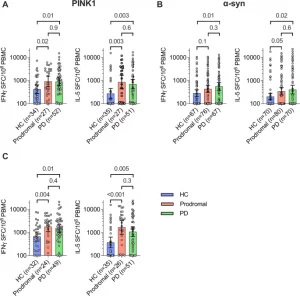T cells are essential defenders of the immune system, but in some cases, their activity turns against the body—damaging healthy tissues and triggering autoimmune diseases like type 1 diabetes and rheumatoid arthritis. Emerging research now suggests that these immune cells may also be involved in the development of Parkinson’s disease, long before the appearance of hallmark symptoms.
In a new study researchers at the provide the strongest evidence yet that T cells reactive to proteins implicated in Parkinson’s emerge during the prodromal stage of the disease – years or even decades before a clinical diagnosis (Figure 1).

Figure 1: PD and prodromal donors have elevated T cell responses towards PINK1 and α-syn. Magnitude of IFNγ and IL-5 mediated T cell responses towards PINK1 (A) and α-synuclein (α-syn; B) in healthy controls (HC), prodromal, and Parkinson’s disease (PD) donors. Magnitude of pooled IFNγ (left panel) and IL-5 (right panel) responses to PINK1 and α-syn (C), in donors screened for reactivity towards both peptide pools. Each circle represents an individual donor. P-values from two-tailed Kruskal-Wallis tests followed by an uncorrected Dunns’ test, and geometric mean ± 95% confidence interval are shown.
Alpha-synuclein and PINK1 are involved in the health and function of neurons. But the timeline of this immune reactivity remained unclear: Were T cells responding to the disease after it had taken hold—or could they be part of the disease’s initiation?
To investigate, the team studied individuals at high risk for Parkinson’s. These participants carried genetic risk factors and displayed prodromal signs, such as loss of smell or REM sleep disturbances—subtle symptoms thought to precede the onset of Parkinson’s by years.
Using a technique called Fluorospot, the researchers analysed blood samples to measure T cell responses to alpha-synuclein and PINK1. Their findings were interesting: T cell reactivity peaked during the prodromal phase, even before traditional motor symptoms like tremors had begun. In particular, T cell responses to PINK1 were strongest before diagnosis, suggesting an immune component to early disease development.
Despite limitations, the correlation between heightened T cell reactivity and early disease stages is difficult to ignore and offers a new avenue for research into both diagnosis and intervention.
The possibility that T cell activity could serve as an early warning sign for Parkinson’s opens exciting diagnostic possibilities. Detecting T cell reactivity before symptom onset could allow clinicians to identify high-risk individuals and monitor or treat them before significant neuronal damage occurs. Not all T cells are harmful – some subsets may help regulate inflammation and protect brain tissue. Understanding these protective populations could help researchers rebalance the immune response in Parkinson’s and other neurological disorders.
As research continues, this work highlights a growing appreciation for the role of the immune system in brain health – and points to the possibility that Parkinson’s may, in part, be an autoimmune disease in disguise.
Journal article: Johansson, E., et al. 2025. T cell responses towards PINK1 and alpha-synuclein are elevated in prodromal Parkinson’s disease. npj Parkinson’s Disease.
Summary by Stefan Botha










